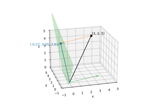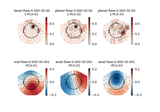mne.compute_proj_raw#
- mne.compute_proj_raw(raw, start=0, stop=None, duration=1, n_grad=2, n_mag=2, n_eeg=0, reject=None, flat=None, n_jobs=1, meg='separate', verbose=None)[source]#
Compute SSP (signal-space projection) vectors on continuous data.
This function aims to find those SSP vectors that will project out the
nmost prominent signals from the data for each specified sensor type. Consequently, if the provided input data contains high levels of noise, the produced SSP vectors can then be used to eliminate that noise from the data.- Parameters
- rawinstance of
Raw A raw object to use the data from.
- start
float Time (in sec) to start computing SSP.
- stop
float Time (in sec) to stop computing SSP. None will go to the end of the file.
- duration
float Duration (in sec) to chunk data into for SSP If duration is None, data will not be chunked.
- n_grad
int Number of vectors for gradiometers.
- n_mag
int Number of vectors for magnetometers.
- n_eeg
int Number of vectors for EEG channels.
- reject
dict|None Epoch rejection configuration (see Epochs).
- flat
dict|None Epoch flat configuration (see Epochs).
- n_jobs
int The number of jobs to run in parallel (default
1). If-1, it is set to the number of CPU cores. Requires thejoblibpackage. Number of jobs to use to compute covariance.- meg
str Can be ‘separate’ (default) or ‘combined’ to compute projectors for magnetometers and gradiometers separately or jointly. If ‘combined’,
n_mag == n_gradis required and the number of projectors computed for MEG will ben_mag.New in version 0.18.
- verbosebool |
str|int|None Control verbosity of the logging output. If
None, use the default verbosity level. See the logging documentation andmne.verbose()for details. Should only be passed as a keyword argument.
- rawinstance of
- Returns
- projs:
list List of projection vectors.
- projs:
See also

